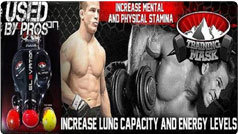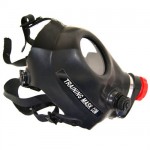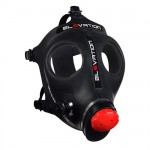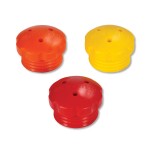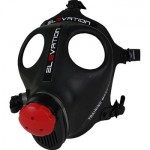
When it comes to survival in combat, whether in a cage or in a street fight, your cardio will always be the one that will keep you going and living to fight for another night. One of the best ways to improve your cardiovascular endurance is to restrict your breathing and oxygen intake through high elevation training. If you can’t bring yourself to the highlands, let the pressure of the highlands come to you.
Elevation Training Masks are the best equipment that uses the same conditions as high altitude training. Elite level athletes who train while wearing Elevation Training Masks are dealing with the same amount of oxygen as if they’re training on top of a mountain. Due to the effects of inhibited oxygen exchange in high altitudes, these world-class individuals perform at a higher work rate, with more stamina to boot, due to a better breathing environment in lower altitude locations.
Training in limited oxygen consumption makes your entire body adapt to its atmosphere in different ways. Thanks to a restricted air pressure, the oxygen transfer from your lungs to your entire body experience a dramatic rise, due to a more efficient production of red blood cells and small blood vessels to your body. One of the most important natural hormones that play an important part in the process of improving your cardio is Erythropoietin, or EPO. Your EPO is a glycoprotein hormone that controls your body’s red blood cell production.
Using the Elevation Training Mask is also a great solution to people who currently suffer from asthma, a medical condition wherein most asthmatics tend to over breathe due to an airflow obstruction or an inflammatory disease in the airways. Wearing an Elevation Training Mask will train their lungs to a more controlled breathing, and experts have theorized a probable cure for asthma, if done regularly.
The human blood is also another catalyst in improving our cardio. Blood is a body fluid that is pumped by the heart, and circulated to the entire human body through the vascular system. Our blood is responsible for two things: it transports ions, compounds and other elements from one tissue or cell to another, and it protects us from diseases.
Speaking of red blood cells, one of the elements that it transports to our body is oxygen. Each red blood cell contains a pigment called hemoglobin, which binds four oxygen molecules, thus forming Oxyhemoglobin. These oxygen molecules are distributed to individual cells in tissues in our bodies, in which these are released. The process of binding the oxygen is called a reversible action, written as such:
Hb + 4O2 => Hb.4O2
The hemoglobin’s diagram above, where it shows four oxygen disks, points out where the oxygen molecules are bound, while the polypeptide chains are represented by four elongated figures.
Oxyhemoglobin only forms when oxygen concentrations are high, but with lox oxygen concentrations, the oxygen and hemoglobin separates both elements. With low oxygen concentrations, hemoglobin is unbound from the blood, thus making the hemoglobin count in your body tissues very low, or none at all. With high oxygen concentration, you will see a formation of Oxyhemoglobin.
Take note that oxygen and carbon dioxide concentrations, also known as oxygen or carbon tension, are commonly known as partial pressures measured in kPa. The quantity of oxygen bound by hemoglobin is expressed in percentage.
The oxygen dissociation curve can be used to demonstrate Le Chatalier’s Principle, which declares that a dynamic equilibrium system reacts to any type of stress by rebuilding the equilibrium.
As aforementioned above, our body is also affected by carbon dioxide exchanges, aside from oxygen. In fact, hemoglobin can bind carbon dioxide as well, although to a lesser extent. While binding oxygen forms Oxyhemoglobin, Carbaminohaemoglobin is formed in this process. Carbon dioxide is carried to the lungs from respiring tissues using this form.
The presence of carbon dioxide in the body helps release oxygen from hemoglobin, which is known as the Bohr Effect. The Bohr Effect can be seen when comparing oxygen dissociation curves with lesser carbon dioxide presence and when there’s more carbon dioxide in our blood.
Once carbon dioxide is dispersed into the blood and into erythrocytes in the presence of Carbonic Anhydrase, a type of catalyst, most carbon dioxide responds when there is water in the erythrocytes, and a dynamic equilibrium is established.
H2O + CO2 => H2CO3
Carbonic acid, H2CO3, dissociates to form hydrogen ions and hydrogen carbonate ions. This is also a reversible reaction and undissociated carbonic acid, hydrogen ions and hydrogen carbonate ions exist in dynamic equilibrium with one another.
H2CO3 => H+ + HCO3–
The Chloride Shift is seen when negatively charged HCO3– ions are diffused from the cytoplasm to the plasma inside the erythrocytes, which is balanced by the distribution of chloride ions to the opposite side, to maintain a balance of negative and positive ions for either side.
The separation of carbonic acids raises the blood’s acidity (which reduces its pH level). Hydrogen ions react with Oxyhemoglobin, releasing the oxygen bound by hemoglobin, to reduce the blood’s acidity. This action allows carbonic acid in large quantities to be transported in the blood without changing the blood’s pH levels.
Hb.4O2 + H+ => HHb+ + 4O2
The Bohr Effect is accountable for the reversible reaction of the entire process. Carbon dioxide is actually a waste product of respiration, and hemoglobin in turn releases oxygen due to the high concentration of the respiring cell.

